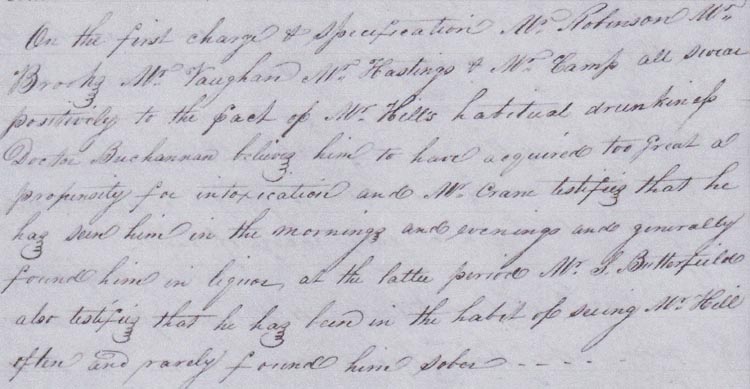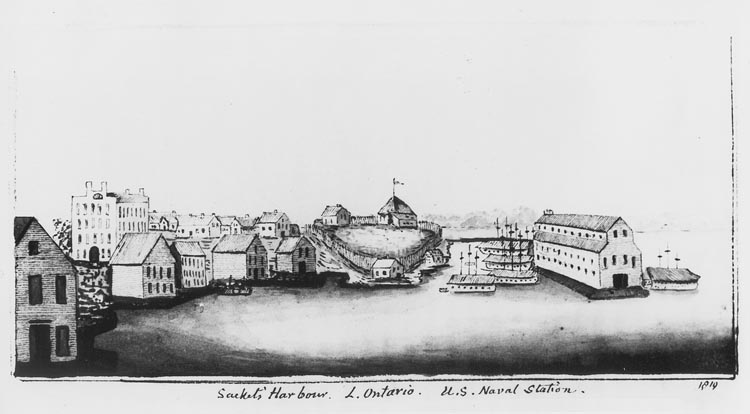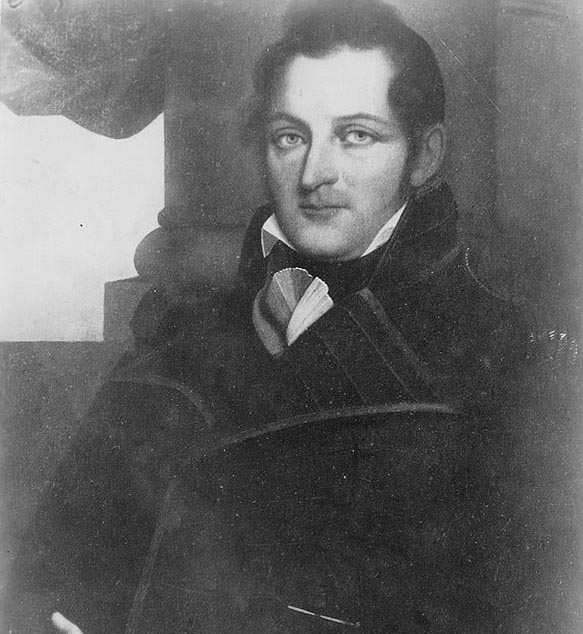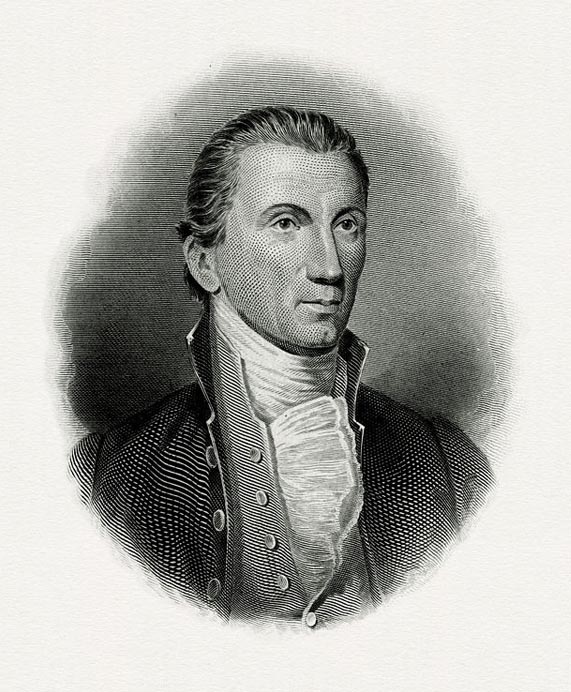BIOGRAPHICAL SKETCHES
Commodore John Cassin (1760-1822)
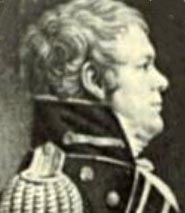
Commodore John Cassin, an important leader during the developmental years of the Washington Navy Yard, led the vital defense of Gosport Navy Yard during the War of 1812 and served as its Commandant during a formative era. John Cassin has been described by one distinguished naval historian as an "experienced and capable seaman" with "tested skills as manager and commander; a reliable officer."1 Cassin was born in Philadelphia, Pennsylvania, on 7 July 1760, the son of Daniel Cassin, an industrious Irish Catholic immigrant from Dublin. During the American Revolution at age 17, Cassin joined the Pennsylvania Militia as a private, where he participated in the Battle of Trenton. He was later appointed First Mate of Pennsylvania privateer schooner the Mayflower on June 27, 1782.2 His physical description as entered on the Mayflower’s muster lists his age as: "23 years, height 5 feet 10 inches tall, hair dark brown with a fresh complexion."3 After the Revolution, Cassin continued on at sea as a merchant seaman where he was twice shipwrecked. In the early 1780’s Cassin married Ann Wilcox of Philadelphia. The young couple had four children who reached adulthood. They were: Elizabeth Ann Cassin, Joseph Cassin (1784-1821), Stephen Cassin (1783-1857) and John Cassin. Two of the couples' sons became naval officers: Joseph Cassin, a naval purser, and Stephen Cassin, a hero of the war of 1812, later appointed Commodore. Cassin’s daughter, Elizabeth Ann Cassin, married naval officer Captain Joseph Tarbell who led in the repulse of British forces from Craney Island on 22 June 1813.4
1 McKee, Christopher A Gentlemanly and Honorable Profession: The creation of the U.S. Naval Officer Corps, 1794 -1815, Naval Institute Press: Annapolis, 1991, p. 188.
2 Ignatius, Martin and Griffin, Joseph Catholics and the American Revolution, Volume 3, Philadelphia, Pennsylvania, 1911, p. 390.
3 Montgomery, Thomas Lynch, editor, Pennsylvania Archives, Series 5, Harrisburg Publishing Company: Harrisburg, p. 657.
4 Heidler, David Stephen and Heidler, Jeanne T editors The Encyclopedia of the War of 1812, Naval Institute Press: Annapolis, 2004, p. 130.
The establishment of the new federal navy created a need for experienced sea going officers and gave John Cassin his opportunity, and he was directly appointed a lieutenant on 13 November 1799. In 1803 he was assigned one of his first important jobs as second officer at the Washington Navy Yard. The Secretary of the Navy, Robert Smith, in his letter appointing Cassin stated his responsibilities for the administration of the navy yard. Smith’s letter provides valuable insight as to duties and responsibilities of a naval officer at an early federal shipyard:
The public property at this place belonging to the Navy Department requires the superintendence be vigilant, active, and intelligent, and You will consider yourself hereby invested with the charge of all the Vessels that are or may hereafter be in ordinary at this place – also of all the stores and also public property now at the Navy Yard, or that may hereafter be deposited there excepting the Small Arms which are to be in charge of Col. Burrows. The stores now here, you will receive by inventory from Captain Tingey, upon which you will be charged and held accountable for their Expenditure. – You will give Receipts for all issues you make. –
It is expected that You will immediately take measures for cleansing each Ship, and for the putting her as far as your means will admit, in a state of preservation, and ready for service as far as their dismantled state will admit, and that You will adopt such a discipline as will keep them all in that state. It is also expected that You, as far as may be practicable, arrange all the different stores, having the stores of each Vessels placed separately and distinctively that you will have all the cordage, Sails, Water casks, Boats & completely overhauled and put into a state fit for service, and it's further expected that you will from time to time communicate to me such improvements in the arrangements at the Yard as your Experience may suggest.
To enable you to execute the duties of this appointment, You will have a Clerk under you and You are hereby invested with the Command of all Officers and Men now at the Yard or onboard the Ships, or that may hereafter be attached to either.
You are allowed the frigate United States and her furniture for your accommodation and you will receive for your services the pay and rations allowed by Laws to a Master Commandment.5
5 Naval Documents Related to the United States Wars with the Barbary Pirates Volume II Naval Operations including Diplomatic Background from January 1802 Through August 1803, editor Dudley W. Knox, Government Printing Office: Washington DC, 1940, pp. 388-389.
On 10 January 1804 Cassin was made superintendent of WNY; his appointment was to fill the vacancy created when Thomas Tingey declined the position. Tingey had refused over issues of his pay and benefits but was later reappointed.6 Tingey and Cassin were a good team, though of differing temperaments. They got on well together and it was Cassin’s systematic mind combined with Tingey’s practical experience running a federal shipyard that allowed them to write the first regulations for the governance of naval shipyards. One of John Cassin’s continuing concerns was the training and development of an officer cadre. He was particularly sensitive to that reality that officers stationed ashore be employed fully, that "they will avoid setting an evil example of idleness and inactivity. While at sea sailing masters, boatswains, gunners, and carpenters all have important duties to discharge". Cassin then wrote "officers on shore station needed to live on the ships in ordinary" and to ensure their vessels and the crews were inspected at least once a day and their ships be kept "clean and sweet" and most of all ready for sea. Cassin proposed that all these activities be placed under the direction and supervision of a "master of the yard."7 Cassin’s recommendations, which were accepted by Tingey, led to the streamlining of the maintenance and repair of naval ships in ordinary. More importantly his ideas marked the real beginning of legislation to provide shipyard commandants and their deputies a permanent supervisory staff of salaried civilian employees.8 In April 1806 Cassin was promoted to Master Commandant. Tingey and Cassin worked together for over ten years with no serious issues and Cassin’s two sons, Stephen, a hero of the War of 1812, and Joseph, a purser, would later work for Commodore Tingey as well.
6 Smith to Cassin 10 January 1804, The secretary stated his expectations: "All the workmen, laborers &c employed in the yard or repairing the Ships &c are to be employed under the direction and control of the Superintendent of the Yard, and to be paid for their services such compensation as may be agreed on with him." Naval Documents Related to the United States Wars with the Barbary Pirates Volume III, Naval Operations including Diplomatic Background from September 1803 Through March 1804 editor Dudley W. Knox, Government Printing Office: Washington DC, 1941, pp. 320-321.
7 Naval Documents, Volume III, pp. 392-393.
8 Brown, Gordon S. The Captain Who Burned His Ships: Captain Thomas Tingey, USN, 1750-1829,Naval Institute Press: Annapolis, 2011, pp. 53, 55, 59-60.
On July 3, 1812 Cassin was promoted to Captain, then the highest rank in the United States Navy. At the beginning of the War of 1812, he led the United States Navy in the defense of Philadelphia. His competence there led to a new appointment. On August 10, 1812, he was designated the new Commandant of Gosport Navy Yard, a position which he held until June 1, 1821. Cassin wrote to Secretary of the Navy Paul Hamilton two weeks after his arrival and described his new quarters and command as wanting in comfort and civilian mechanics:
"I have the honor to inform you of my arrival at this place on Sunday last after a very disagreeable passage of ten days heavy gales & rainey weather and [I am ] extremely unwell, but by the assistance of Doctor Schooflield I am much better. I caught a violent cold in the river, followed up by going into the house which is too Small entirely for my family and on the first night we had 18 inches of water in the cellar, when I was complel’d to partake of your liberal instructions as it respects my quarters by making two Small wings & kitchen to the House, my Office is too small and under the Hospital, whenever they wash it, the water runs all over me, books & everything. I find we are in want of everything to make it like a Navy Yard."
"We are much in want of a Master Blacksmith, also a Plumber and Joiner. I should recommend John Bishop & Willm Saunders from King’s Shop, also Nicholas Fitzpatrick Joiner,9 there is a very Smart man Boat builder who formerly worked under me at the Yard which is now employed at Norfolk by piece work for the Navy, which I do not admire. I would beg leave to recommend him also should it meet your approbation to get me these workmen with the addition of a few Shops to be able to Save a good deal of outdoor work, all of which I have the honor to submit for your Consideration."10
9 Nicholas Fitzpatrick had worked with John Cassin at the Washington Navy Yard and is enumerated on the payroll for July 1811 as a ship joiner, NARA RG 45. Fitzpatrick is also mentioned in a 15 April 1817 letter from Tingey to the Board of Navy Commissioners stating that Fitzpatrick and others came to the United States "at or under 8 years of age - having served all their youth to the trade and worked long in the yard - consider themselves citizens." John Bishop and William Saunders, both blacksmiths, had also worked with Cassin at Washington Navy Yard. The "King’s Shop" reference is to Benjamin King, master blacksmith.
10 Dudley, William S. The Naval War of 1812: A Documentary History, Volume I, Washington DC: Government Printing Office, 1985, pp. 222-223.
Cassin’s arrival at Gosport came at exactly the right moment and at a most critical juncture, for he helped lead the American defense against the British naval attack and assisted in the organization of the fifteen gun boat flotilla that took the offense and engaged and repulsed the Royal Marines, the 102nd Regiment, and two Independent Companies of Foreigners (French mercenaries), plus the H.M. Frigate Junion. After restoring order and security to his new command, Cassin spent the next nine years endeavoring to build up the young naval yard and develop and train its officers and provide Gosport with a group of experienced master mechanics.
In June of 1821 he was chosen to be the Commanding Officer of the Southern Naval Squadron based at Charleston, South Carolina. As leader of naval squadron Cassin was accorded the honorary title Commodore. Despite his advancement and honors, his last years were hard for Cassin, as he suffered terrible losses. In 1819 his younger son Joseph, a naval purser, died while on station aboard the frigate Porpoise, off Pensacola, Florida. His daughter Elizabeth Ann died on 23 November 1821, and his beloved wife and partner of forty years, Ann Wilcox Cassin, died while he was at sea in 1821. Just shortly after his arrival in the city of Charleston to take up his new post, Commodore Cassin died on 24 March 1822. John Cassin was buried with full military honors at the cemetery of St Mary’s of the Annunciation. In his obituary the Charleston Courier editor noted Cassin’s long service to the nation despite lingering illness, and his goodness of heart and character led all who knew him to esteem him.11While John Cassin never gained the heroic victories at sea enjoyed of some of contemporaries, he served for two decades in a succession of critical shore assignments where the navy department knew they could always depend on his tested skills as an innovative manager and naval officer.12
11 Charleston Courier, 24 March 1822.
12 McKee, p. 188.
* * * * * * * * * *
1812 Letters: These two early letters from Captain John Cassin are both dated 25 August 1812. The first is to the Secretary of the Navy, Paul Hamilton, and the second to Commodore Thomas Tingey at Washington Navy Yard. Cassin had arrived at Gosport, Virginia, on 23 August 1812 after “a very disagreeable passage” of ten-days in heavy gales and rain. He was accompanied by his wife and family and was “extremely unwell’ during the voyage. Both letters provide a rare glimpse of the early Gosport (Norfolk) Navy Yard and Captain Cassin’s first impressions of his new command. As noted in the letters, accommodations for officers were far from comfortable, indeed most “habitations were Spartan,” the Navy Yard buildings were few and consequently much work was done out in the open.
Navy Yard Gosport
25th August 1812Sir,
I have the honor to inform you of my arrival at this place on Sunday last, after a very disagreeable passage of ten day heavy gales & rainy weather and [I am] extremely unwell, but by assistance of Doctor [Joseph S.] Schoolfield, I am much better. I caught a violent cold in the river followed by going into the house which is too small entirely for my family and on the first night we had 18 inches water in the cellar, when I was compelled to call all hands to pump or bail the Ship out. I shall be compelled to partake of your liberal instructions as respects my quarters by making two small wings & kitchen to the House, my office is too small and under the Hospital [and] whenever they wash it runs all over me, books & everything. I find we are in want of everything to make it like a Navy Yard. On my arrival five Schooner Gunboats were under sailing orders for North Carolina, two of which I have had to order up to the yard to heave out again and in hopes will be able to leave this week. I have ordered Lieut Henley to Command the Flotilla which is stationed down below the Town, until your pleasure is known on the subject.
We are much in want of a Master Blacksmith, also a Plumber and Joiner. I would recommend John Bishop & William Saunders from King’s Shop, also Nicholas Fitzpatrick, Joiner. There is a very Smart Boat builder who formerly worked under me at the yard, which is now employed at Norfolk by piece work for the Navy, which I do not admire. I would beg leave to recommend him also should it meet your approbation to get me three workmen with the addition of a few Shops to be able to save a good deal of the out door work, all of which I have the honor to submit for your consideration, Respectfully [&c.]
John Cassin
The Honorable Paul Hamilton
Secretary of the Navy* * * * *
Navy Yard Gosport
25th August 1812Sir,
I arrived here on the 23rd after a very tedious passage and very unwell, but on getting on shore, and putting myself into the Doctor hands, I have recovered so as to enable me to attend to duty. I found five Gun boat schooners dressed down under sailing orders for North Carolina, but immediately on my arrival two of which applications were made for survey, which I ordered and were obliged to order the Yard to heave out again. Potts is now employed in that service; you cannot conceive the difference in my House at present and that I left. I shall be compelled to put two wings to it and build a kitchen, the night we arrived we had 18 inches of water in our kitchen which is under the house and had to call all hands to clean Ship –
I find our yard in want of everything [as] we have not one pound of shot lead in the Yard. I would wish you would send the Navy Storekeeper Six rolls of shot lead, also twelve small Ensigns and Pendants for the Gunboats. There is no Bunting here, we have not a Flag to hoist in the Yard. I will thank you to have me two ensigns make up one, 10 x 18 inches, and the other 14 x 20 for the Yard, an Ensign an elegant staff erected but not Flag in the yard. We are also in want of a head Blacksmith, a Joiner, a Plumber, Cooper and, in fact everything to make it like a yard - My Clerk who is a very Smart man has everything to do, call the roll, enter all the accounts &c, &c which keep him busy from Morning till Night. He is a very deserving man I hope in a few days to get strong but everything startles and surprises me - I think I often look like a Cat in a Strange garret. May heaven preserve you in health & happiness is the wish of your old friend –
John Cassin
P.S. Be good enough, to send me my six musket & pistol molds
To Commodore Thos Tingey
* * * * *
1817 Letters: Lieutenant John Hill Jr., USN, showed little aptitude or enthusiasm for a naval career. His commanding officers reported his main focus was drink and good time. His overall record shows he quickly developed a problem with chronic drinking that today would probably be classified as alcoholic. During much of Hill’s lifetime, though, alcohol was considered a benign beverage and widely thought to have health-giving properties. In 1819 those like Lt. Hill, who were so frequently and visibly drunk as to imperil themselves or others, were considered either "moral failures, undisciplined, ungodly or degenerate."1, 2
1 The American Medical Association (AMA) declared that alcoholism was an illness in 1956.https://www.ama-assn.org/delivering-care/public-health/court-listened-ama-defining-alcoholism-disease-not-crime See, Henry, Tanya Albert, American Medical Association, Court listened to AMA on defining alcoholism as a disease, not a crime, August 16, 2019.
2 Roarbaugh, W. J. The Alcoholic Republic An American Tradition, Oxford University Press, New York, 1979), p.241.
Hill was born near Salem, Maine, circa 1795 and was appointed a Midshipman on 6 February 1809. His initial assignment was to Gun Boat number 10 at St. Mary’s, Maryland, but that appears to have been delayed or the order rescinded. Hill then requested a furlough so that he might take service with a merchant vessel for Europe. Not able to find a ship bound for Europe, he "undertook one bound to Savannah, Georgia, and from thence to Europe."3 Hill claimed this too did not work out as planned as he was taken sick and accordingly returned to Salem. From Salem he finally managed to get a merchant vessel bound for Europe, later taking a Danish merchant ship for the return passage voyage. At home he learned from his father that he had received orders from the Navy to report to Norfolk, Virginia.4
3 John Hill Jr. to Paul Hamilton, 23 July 1810, Navy Officers Letters 1802-1884, Volume 15-16, 2 July 1810-31, May 1811, RG 45, National Archives and Records Administration Washington, D.C.
4 John Hill Jr. to Paul Hamilton, 23 June 1811, Navy Officers Letters, 1802-1884, Volume 17-18, 2 June 1811 to 31 May 1812, RG 45, National Archives and Records Administration Washington, D.C.
At his new assignment Hill’s problem with drink and public intoxication quickly became evident and a general embarrassment to the Navy Yard. Hill’s public drunkenness forced Commodore John Cassin’s on 7 February 1817 to report the problem to Secretary of the Navy.5 Commodore Cassin felt some compassion for the young man and recommended to the Secretary of the Navy that Lt. Hill be given yet another chance to improve. The Secretary of the Navy signified his approval on the reverse of the letter below.
5 Cassin to Crowninshield, 7 February 1817, Letters Received by the Secretary of the Navy from Captains ("Captains' Letters") 1805-61; 1866 to 1885, volume 52, letter number 39, RG 260, National Archives and Records Administration, Washington, D.C.
Navy Yard Gosport
February 7th 1817Sir,
Having been compelled to direct Lieutenant John Hill to apply to the Department for removal from this Station on account of his conduct on the evening of the 16th, presuming it to be the most mild step which could be taken with him; that it created some jealousies among the officers for this leniency shown him; and threats were made to remonstrate having done this, I have taken the liberty to show the cause; on the evening of the 16th of January a ball was given by the Citizens of Norfolk for Captain Warrington, where all the officers of the Navy and the Army were invited.6 Lieutenant Hill having made to free with the ardent entered the ball, very much intoxicated, so much so to appear ridiculous to all around him. I being called by Lieutenant Commandant Nicholson to see his condition, waited until the dance was over, when I took the opportunity and called him, Mr. Hill, outside into the hall, where he gave some insolence, but perceiving his situation ordered him to leave the house. Next morning Mr. Hill came to my office and made suitable apology for the occasion, being induced to do this measure from a conviction that he is not in the practice of such abuses, which I hope will meet your approbation, and as I think a more active employment would be of service to him.
I have the honor to be Sir your obedient servant.
[Signed] John Cassin
To: The Honorable Benj. Crowninshield
Secretary of the Navy6 Hill, John, Jr. Appointed Midshipman, 6 February, 1809. Lieutenant, 27 April, 1816, he was discharged by Court-martial, 6 October, 1819. Naval History and Heritage Command, Officers of the Continental and U.S. Navy and Marine Corps 1775-1900. https://www.history.navy.mil/research/library/online-reading-room/title-list-alphabetically/o/officers-continental-usnavy-mc-1775-1900/navy-officers-1798-1900-h.html accessed 16 April 2021
Subsequently Hill was reassigned to the USS Jones, a brig, at Naval Station, Sacket’s Harbor, New York. The Jones was launched in 1814 as part of the American effort to protect the Great Lakes from British incursion and in 1819 she served as a receiving ship, decrepit and soon to broken up in 1821. Lt. Hill spent much of his time at local bars and was apparently unable or unwilling to change. He even appeared at the Sacket Harbor cotillion ball in uniform, obnoxious, and intoxicated. His new commanding officer, Commodore Melanchthon Taylor Woolsey, was not amused and promptly had Hill brought up on charges.
Commodore Woolsey to Smith Thompson, 16 June 1819 re Lt. John Hill Jr. desertionHill compounded his infraction by going absent without leave. According Commodore Melanchthon Taylor Woolsey (1782 to 18 May 1838), Hill fled the Naval Station in a stage coach to Utica, New York, where he was later found and arrested at a public bar. During his failed escape attempt Hill somehow managed to break his arm. Hill was returned to Sacketts Harbor Navy Yard where he was held under guard until his court martial.7
7 Woolsey to Smith Thompson, 16 June 1819, Letters Received by the Secretary of the Navy from Captains ("Captains' Letters") 1805-61; 1866 to 1885, 1 June 1819 to 29 July 1819, volume 63, letter number 38, RG 260, National Archives and Records Administration, Washington, D.C.
Testimony at Lt. John Hill’s 1819 court martial, recounting his "propensity for intoxication".Lieutenant John Hill Jr. court martial was held on the Brig Jones, at Sackets Harbor on 5 July 1819. Among the charges:
Charge 1. that Lieutenant John Hill has repeatedly and almost consistently been intoxicated with liquor between 24 November 1818 and the 4th of May 1810.
Charge 2. Conduct unbecoming an officer and gentleman.
Charge 3. on the 23rd of March at a public ball at the house of Elijah Field Jr. Esq. at this place he disgraced himself and injured the public service.
Charge 4. He was seen in public 16 April 1819 exposing himself in the public street to ridicule.8
8 Records of General Court Martials and Courts of Inquiry of the Navy Department, 1799 -1867 Case Number 341, Volume 10, 1819-1820, Court Martial of Lt. John Hill Jr., pp 1-226, RG 125, NARA, Washington, D.C.
Just prior to the trial two additional charges were brought against Hill:
1. Breaking his arrest; In that Lieutenant John Hill Jr. did on or about the ninth of May 1819 leave the bounds of this village contrary to the orders of his commanding officer.
2. In that, Lt. John Hill Jr did on or about the 16th day of June leave the station and proceed to Utica, New York.
At Hill’s court martial, navy physician Doctor Walter W. Buchanan who had seen much active service, when asked to sum up Lt. Hill’s medical condition and whether he was a drunk, simply stated Hill, had "acquired too great a propensity for intoxication…"9 In 1819, Sackets Harbor, New York, was perhaps not the best location for Lt. Hill. The town and shipyard had a poor reputation with sailors.10 The Sacket’s Harbor Naval Station was known both for its harsh environment and its tough commander who had a reputation for severe discipline.11
9 Buchanan, W. W., Surgeon, USN 24 July, 1818, resigned 8 December, 1827. Naval History and Heritage Command , Officers of the Continental and U.S. Navy and Marine Corps 1775-1900, https://www.history.navy.mil/research/library/online-reading-room/title-list-alphabetically/o/officers-continental-usnavy-mc-1775-1900/navy-officers-1798-1900-b.html accessed 16 April 2021
10 Gibson, Gary M. "Militia, Mud, and Misery: Sackets Harbor during the War of 1812." New York History, vol. 94, no. 3-4, 2013, pp. 241–266. JSTOR, www.jstor.org/stable/newyorkhist.94.3-4.241, accessed 16 Apr. 2021
11 McKee, Christopher A Gentlemanly and Honorable Profession, The Creation of the U.S. Naval Officer Corps, 1794-1815 (Naval Institute Press, Annapolis, 1991), p. 245.
The remote area where the shipyard was located on Lake Erie added to its overall isolation combined with a reputation for meager food, poor clothing and the barest of accommodations. As a consequence of the Station’s low morale, the desertion rate during the early nineteenth century remained high. The muster rolls for Sackets Harbor Naval Shipyard reflect a desertion rate among enlisted men reaching a high of 19 during the second quarter of 1814.12 The rate in 1819 still remained high, of the 118 officers and men assigned, 12 enlisted men deserted over the course of the year.13
12 Gibson, Gary M. "Militia, Mud, and Misery: Sackets Harbor during the War of 1812." New York History, vol. 94, no. 3-4, 2013, pp. 241–266. JSTOR, www.jstor.org/stable/newyorkhist.94.3-4.241, accessed 16 Apr. 2021
13 Miscellaneous Records of the Navy Department, Muster Rolls, Sacketts Harbor 1819, 1 October 1818 to 30 September 1819, RG-45, National Archives and Records Administration, Washington, D.C. Lt. John Hill Jr. enumerated as number 19.
Muster Roll 1819, Sackets Harbor, Lt John Hill Jr. number 19,
"Dismissed… Oct, 1819, from the Service"After a week of testimony Hill was found guilty of all charges. The court recommended to Benjamin Homans, the Chief Clerk of the Navy Department, that Lt. John Hill Jr. be dismissed from the United States Navy. Homans then secured the Secretary of the Navy, Smith Thompson’s endorsement and forward the recommendation to remove Lt. Hill to President James Monroe. Homans also added a personal note:
In submitting the within letter to the President of the U. States with Mr. Thompson’s endorsement, I beg leave respectfully to state, that the habits and conduct of Lieut. Hill have for a long time rendered him unfit for service and continued admonition and indulgence has had no good effect. The young man is considered as lost by all who know him. I am therefore induced to trouble you with the proceedings for your approval. I am most respectfully Sir, Your Obedient Servant.
[Signed] Benjamin Homans
President James Monroe approved Lt. Hill’s dismissal thus,
"The indented report on Lieut Hill is confirmed."
J. M.
President James Monroe
in office 1817 - 1823
* * * * *
John "Jack" G. M. Sharp resides in Concord, California. He worked for the United States Navy for thirty years as a civilian personnel officer. Among his many assignments were positions in Berlin, Germany, where in 1989 he was in East Berlin the day the infamous wall was opened. He later served as Human Resources Officer in South West Asia (Bahrain). He returned to the United States in 2001 and was on duty at the Naval District of Washington on 9/11. He has a lifelong interest in history and has written extensively on the Washington, Norfolk and Pensacola Navy Yards, labor history and the history of African Americans. His previous books include African Americans in Slavery and Freedom on the Washington Navy Yard 1799 -1865, Morgan Hannah Press 2011 and History of the Washington Navy Yard Civilian Workforce 1799-1962, 2004.
https://www.history.navy.mil/content/dam/nhhc/browse-by-topic/heritage/washington-navy-yard/pdfs/WNY_History.pdf
and the first complete transcription of the Diary of Michael Shiner Relating to the History of the Washington Navy Yard, 1813-1869, 2007/2015 online:
https://www.history.navy.mil/research/library/online-reading-room/title-list-alphabetically/d/diary-of-michael-hiner.html
His most recent work includes Register of Patients at Naval Hospital Washington DC 1814 With The Names of American Wounded From The Battle of Bladensburg 2018,
https://www.history.navy.mil/research/library/online-reading-room/title-list-alphabetically/r/register-patients-naval-hospital-washington-dc-1814.html
The last three works were all published by the Naval History and Heritage Command. John served on active duty in the United States Navy, including Vietnam service. He received his BA and MA in History from San Francisco State University. He can be reached at sharpjg@yahoo.com

